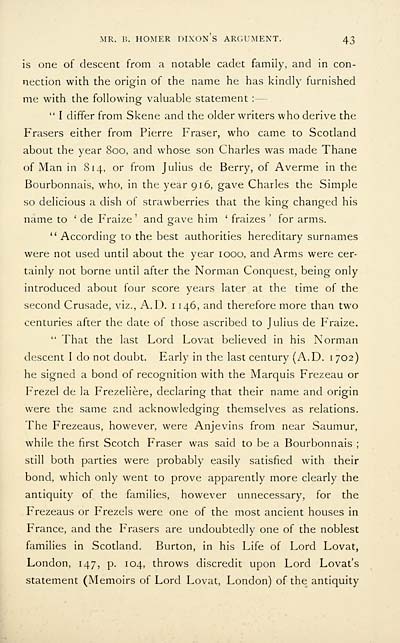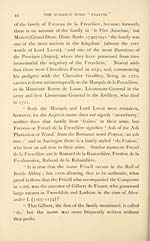Clan Fraser in Canada
(49) Page 43
Download files
Complete book:
Individual page:
Thumbnail gallery: Grid view | List view

MR. B. HOMER DIXON S ARGUMENT. 43
is one of descent from a notable cadet family, and in con-
nection with the origin of the name he has kindly furnished
me with the following valuable statement : —
" I differ from Skene and the older writers who derive the
Frasers either from Pierre Fraser, who came to Scotland
about the year 800, and whose son Charles was made Thane
of Man in 814, or from Julius de Berry, of Averme in the
Bourbonnais, who, in the year 916, gave Charles the Simple
so delicious a dish of strawberries that the king changed his
name to ' de Fraize ' and gave him ' fraizes ' for arms.
"According to the best authorities hereditary surnames
were not used until about the year 1000, and Arms were cer-
tainly not borne until after the Norman Conquest, being only
introduced about four score years later at the time of the
second Crusade, viz., A.D. 1 146, and therefore more than two
centuries after the date of those ascribed to Julius de Fraize.
" That the last Lord Lovat believed in his Norman
descent I do not doubt. Early in the last century (A.D. 1 702)
he signed a bond of recognition with the Marquis Frezeau or
Frezel de la Frezeliere, declaring that their name and origin
were the same and acknowledging themselves as relations.
The Frezeaus, however, were Anjevins from near Saumur,
while the first Scotch Fraser was said to be a Bourbonnais ;
still both parties were probably easily satisfied with their
bond, which only went to prove apparently more clearly the
antiquity of the families, however unnecessary, for the
Frezeaus or Frezels were one of the most ancient houses in
France, and the Frasers are undoubtedly one of the noblest
families in Scotland. Burton, in his Life of Lord Lovat,
London, 147, p. 104, throws discredit upon Lord Lovat's
statement (Memoirs of Lord Lovat, London) of the antiquity
is one of descent from a notable cadet family, and in con-
nection with the origin of the name he has kindly furnished
me with the following valuable statement : —
" I differ from Skene and the older writers who derive the
Frasers either from Pierre Fraser, who came to Scotland
about the year 800, and whose son Charles was made Thane
of Man in 814, or from Julius de Berry, of Averme in the
Bourbonnais, who, in the year 916, gave Charles the Simple
so delicious a dish of strawberries that the king changed his
name to ' de Fraize ' and gave him ' fraizes ' for arms.
"According to the best authorities hereditary surnames
were not used until about the year 1000, and Arms were cer-
tainly not borne until after the Norman Conquest, being only
introduced about four score years later at the time of the
second Crusade, viz., A.D. 1 146, and therefore more than two
centuries after the date of those ascribed to Julius de Fraize.
" That the last Lord Lovat believed in his Norman
descent I do not doubt. Early in the last century (A.D. 1 702)
he signed a bond of recognition with the Marquis Frezeau or
Frezel de la Frezeliere, declaring that their name and origin
were the same and acknowledging themselves as relations.
The Frezeaus, however, were Anjevins from near Saumur,
while the first Scotch Fraser was said to be a Bourbonnais ;
still both parties were probably easily satisfied with their
bond, which only went to prove apparently more clearly the
antiquity of the families, however unnecessary, for the
Frezeaus or Frezels were one of the most ancient houses in
France, and the Frasers are undoubtedly one of the noblest
families in Scotland. Burton, in his Life of Lord Lovat,
London, 147, p. 104, throws discredit upon Lord Lovat's
statement (Memoirs of Lord Lovat, London) of the antiquity
Set display mode to:
![]() Universal Viewer |
Universal Viewer | ![]() Mirador |
Large image | Transcription
Mirador |
Large image | Transcription
Images and transcriptions on this page, including medium image downloads, may be used under the Creative Commons Attribution 4.0 International Licence unless otherwise stated. ![]()
| Histories of Scottish families > Clan Fraser in Canada > (49) Page 43 |
|---|
| Permanent URL | https://digital.nls.uk/95474189 |
|---|
| Description | A selection of almost 400 printed items relating to the history of Scottish families, mostly dating from the 19th and early 20th centuries. Includes memoirs, genealogies and clan histories, with a few produced by emigrant families. The earliest family history goes back to AD 916. |
|---|

